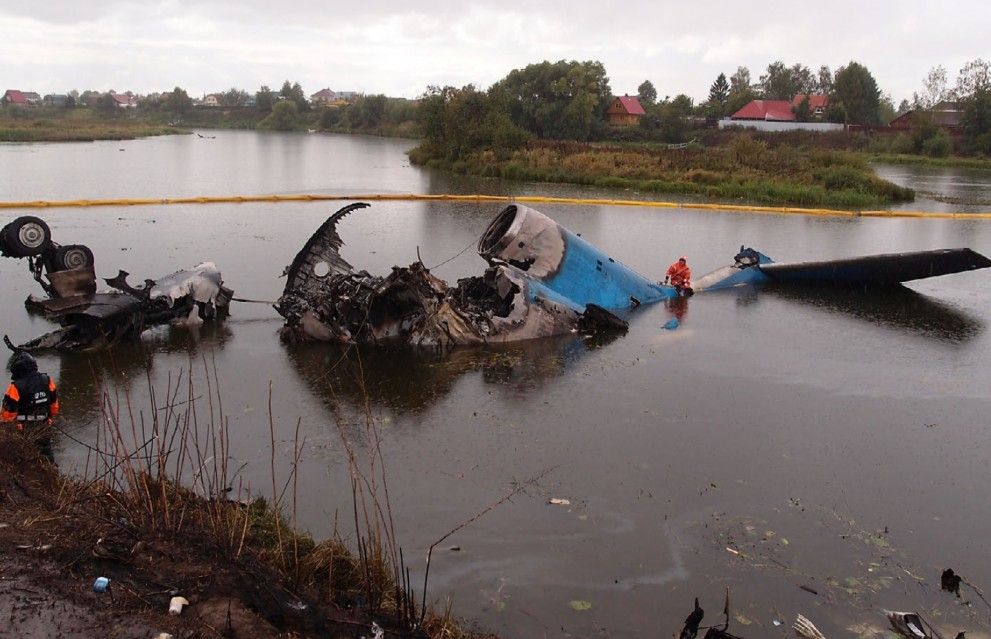While everyone has heard of the February 6, 1958, Munich Air Disaster in which BEA flight 609 crashed during its third attempt to takeoff from a slush-covered runway in Munich, how many of you have heard about YAK-Service Flight 9633? Unlike in the United Kingdom, where soccer is king, ice hockey is the most popular sport in Russia, and is followed by millions of people.
11 years ago today, on Wednesday, September 7th, 2011, the Lokomotiv Yaroslavl ice hockey team was traveling from Tunoshna Airport (IAR) to Minsk-1 Airport (MHP) in Belarus for a match to start the 2011–12 season. At the time, Lokomotiv Yaroslavl was one of Russia's top ice hockey teams. For the 554-mile journey to Belarus, Lokomotiv Yaroslavl chartered an eight-year-old Yakovlev Yak-42D with the registration RA-42434.
Everything looked fine before takeoff
Operated by aircraft charter company YAK-Service, Flight 9633 entered Runway 05/23 at taxiway 5, located 980 feet from the runway threshold. Runway 05/23 was 9,800 feet long, which meant the three-engined aircraft had 8,900 feet for its takeoff run. The pilots set the flaps at 20 degrees (takeoff position) and the stabilizer at -8.7 degrees (nose up).
After performing a control check, the plane accelerated to 140 mph but failed to takeoff. With weather conditions at Tunoshna Airport as perfect as you can get, the aircraft ran out of runway, accelerating 1,300 feet past the end of the runway while finally getting airborne. The YAK-42 then struck an antenna mast at the height of 20 feet above the ground. Following the impact, the plane veered to the left and crashed on the banks of the Tunoshonka River 1.2 miles from the end of the runway. Of the 45 passengers and crew, only one person survived.
Eyewitnesses to the crash gave various accounts of the plane bursting into flames after hitting the mast and the engines going silent shortly before the impact.
The investigation
Immediately following the crash, the Interstate Aviation Committee (MAK) opened an investigation into the circumstances of the accident. The flight data recorders were recovered, and samples were taken of the fuel, which proved to be OK. The flight recorders indicated that the plane's trimmable horizontal stabilizer was set to 8.7 degrees "nose up," and its wing flaps were in the takeoff position of 20 degrees. After examining all three engines, it was determined that they worked correctly until the mast's impact. Initial findings indicated the following:
- The engines were working correctly
- Weather played no role in the crash
- The pilots had carried out proper checks, including control surfaces
- Takeoff weight was less than the maximum allowed
- The flaps were set in the correct position for takeoff
On September 14, 2011, a Moscow newspaper reported that a parking brake was still on during the takeoff. This theory was later debunked by experts who claimed that if the brake was on, there would have been skid marks and pieces of rubber on the runway.
Pilot error due to a lack of training was to blame
After much analysis and speculation in the press, the investigating committee released its final report on November 2, 2011. The committee found that Yak-Service failed to train its Yak-42 crews properly and that the crew failed to calculate the takeoff parameters correctly. It also said that while one of the pilots was increasing thrust, the other applied the plane's brakes. The co-pilot was also found to have phenobarbital, a banned seizure drug, in his system.
Investigators also found that both pilots had falsified documents stating they had undergone the required training on the Yak-42.

.jpg)
.gif)
.jpg)
